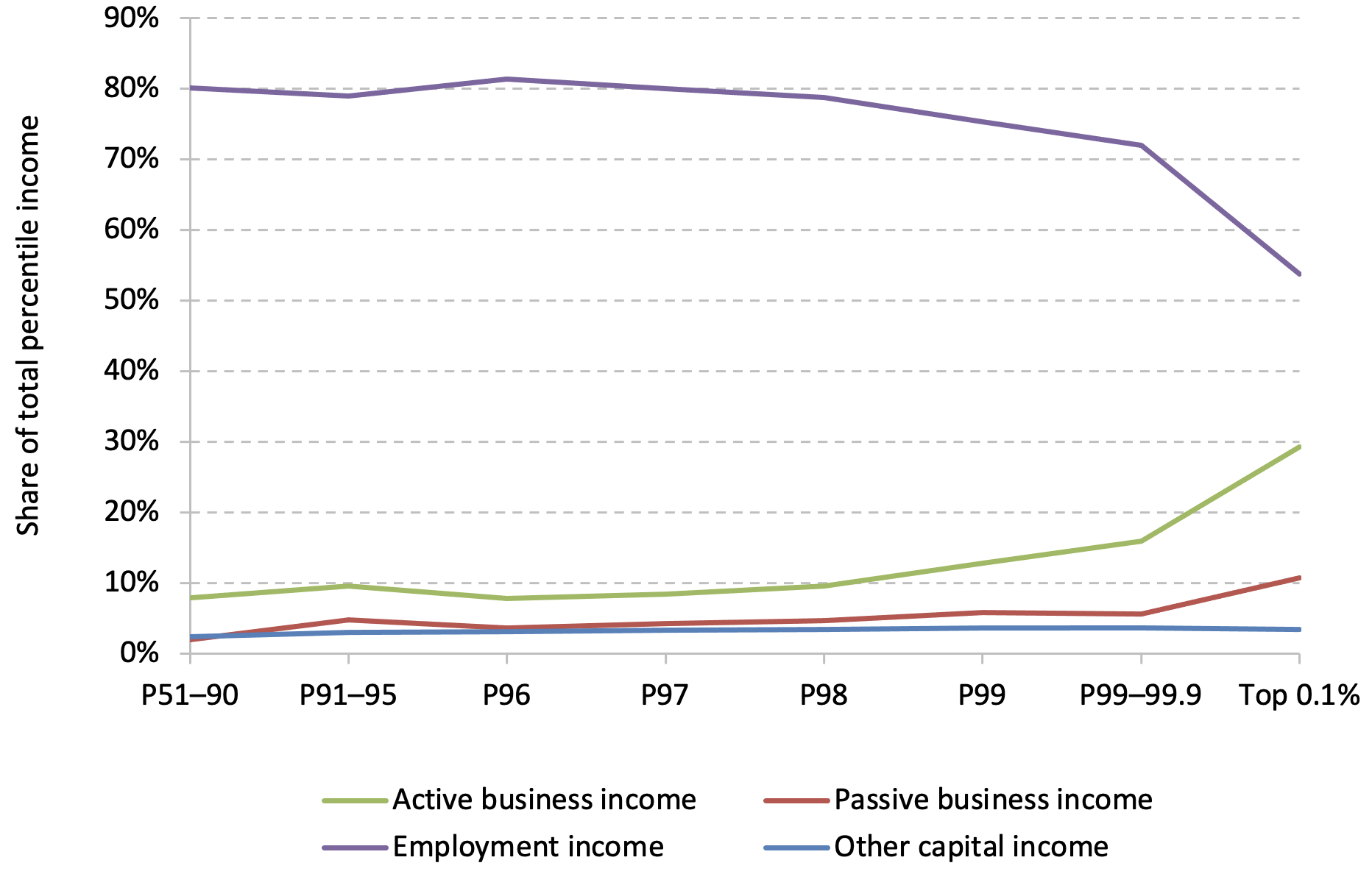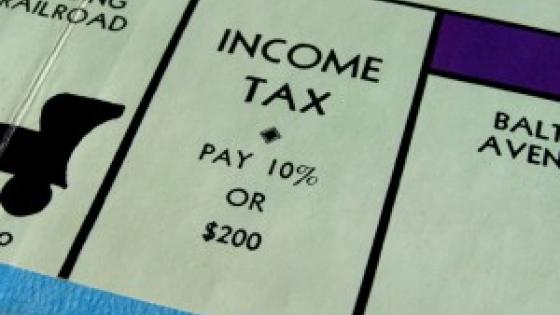How much income do ‘the rich’ receive? From what activities is it derived? And how much tax do they pay? These questions are central to debates around inequality and the appropriate policy solutions. In a July 2021 survey, 58% of Britons “worried” that “the top 1% of earners have more money than the other 99% of people”, and 42% agreed with the statement “the rich should not be able to continue to get richer – it concerns me” (Garrett and Day 2021).
One reason for the renewed focus on income inequality is that the share of income flowing to the very top of the distribution has risen, and is now much higher than it was in the early 1980s. This rise is evident in various English-speaking countries, including Canada, the US, and Australia, but is more modest in continental Europe and Japan (Atkinson et al. 2011, Alvaredo 2017).
Much has been written about the possible causes of rising top income shares. Some theories suggest that growing incomes at the top partly reflect increases in the returns to skill or effort, with technological change and globalisation allowing a small group to capture large markets and reap big returns (e.g. Rosen 1981, Atkinson 2003, Gabaix and Landier 2008, Kaplan and Rauh 2013, Murphy and Topel 2016). Others contend that incomes at the top reflect rents, which may rise, for example, when markets are not competitive and some people are able to capture the benefits ( e.g. Bertrand and Mullainathan 2001, Bivens and Mishel 2013).
In a recent chapter for the IFS-led Deaton Review of Inequalities (Delestre et al. 2022), we provide new evidence on top incomes in the UK and how much tax is paid on them.
One of the most striking aspects of the UK’s (fiscal) income distribution is that those at the top are much more likely to get their income from active business ownership. Figure 1 shows that active business income comprises 21% of fiscal income for the top 1%, and 29% for the top 0.1%, compared with only 9% for adults outside of the top 1%. This is similar to patterns seen in the US, where the importance of business income increases even more sharply for the top 1% (Smith et al. 2019).
Figure 1 Income sources for the top 50% of UK adults, 2018–19
Note: Employment income is inclusive of taxable employment benefits and net of employment-related expenses. Active business income measures dividend income paid to company owner-managers and income from self-employment and partnerships. Passive business income is dividend income paid to non-owner-managers. Other capital income includes all income from interest payments, trusts, and other passive investments as well as income from property.
Source: Figure 3 from Delestre et al. (2022).
This has important implications for the distribution of post-tax income because in the UK, as in many countries, business incomes are taxed at substantially lower rates than employment income. Self-employment income is tax advantaged because this legal form faces no equivalent to the employer social security contributions charged on employment income. Investment incomes, notably including dividends, are not subject to any social security contributions. This benefits those individuals running their own companies, who can choose to take income out of their company in the form of a salary, dividends, or capital gains. Company owner-managers can also access a tax rate of just 27% on up to £1 million of income retained in their company and realised as capital gains – or of 0% if the realisation of gains is deferred until death.
Despite the preferential tax treatment of business income, UK taxes on fiscal income are progressive overall: average tax rates are higher for those with more income, and the top 1% pay a disproportionate and growing share of income taxes. Various policy measures since 2010 have increased the taxes on ordinary income, dividends, and capital gains; as a result, post-tax top income shares have declined relative to pre-tax shares in the past ten years. Nonetheless, the wide variation in rates applied to different types of income creates horizontal inequities; for example, an employee and a partner may get a similar return on their work effort but be taxed at very different rates. It also affects how people behave, with strong incentives to operate through a business legal form or take income as capital. Such responses constrain policy options, including the ability to raise top income tax rates. Current official estimates suggest that raising the top rate of income tax above 45% would recoup very little, at least in part because people can shift income to lower-taxed forms.
Policymakers who wish to raise more revenue could do so by increasing rates of tax on business and capital incomes. However, the effect of taxes, including the way people respond, depends not just on tax rates but also, crucially, on the broader design of the tax system, including the tax base (Slemrod and Kopczuk 2002, Kopczuk 2005). Raising tax rates on capital incomes, given the current design of the tax base, would discourage some savings and investment. This is a key reason that policymakers have tended to favour reduced rates on capital incomes. However, Mirrlees et al. (2011) argue that this trade-off could be largely avoided if the tax base were reformed so that, as far as possible, higher rates did not discourage investment. With a reformed tax base, there would be a strong case to align tax rates across different sources of income.
Although a significant number of high-income individuals respond to taxes by shifting income, there are other ways they can – and do – respond. These includes evasion, including to offshore tax havens (Alstadsæter et al. 2018). Other so-called ‘real’ margins of response to tax include how much to work and in what occupations. This includes individuals’ involvement in innovation, which is particularly important because the creation of new ideas can benefit not only the innovators but also their societies (to the extent that it drives economic growth and incomes more broadly). Akcigit et al. (2022) conclude that higher personal taxes negatively affect the quantity of innovation. Another important response is migration (evidence for this is surveyed in Kleven et al. 2020).
Income inequality is clearly an important and salient form of inequality, with income taxes serving as the main way that governments raise large sums of revenue from those with higher incomes. There is significant scope to reform the taxation of UK incomes and thereby raise more revenue from the top, if desired. But there are alternative ways to raise revenue from ‘the rich’ and to more directly tackle other aspects of inequality. For example, although income taxes will clearly affect how much wealth is accumulated and inherited, changes to inheritance tax could tackle this form of inequality much more directly. More generally, policymakers should pay careful attention to all the ways that people respond in order to design policy that best achieves their aims.
References
Akcigit, U, J Grigsby, T Nicholas and S Stantcheva (2022), ‘Taxation and Innovation in the Twentieth Century’, Quarterly Journal of Economics 137(1): 329–85 (see also the Vox column here).
Alstadsæter, A, N Johannesen and G Zucman (2018), ‘Who Owns the Wealth in Tax Havens? Macro Evidence and Implications for Global Inequality’, Journal of Public Economics 162: 89–100.
Alvaredo, F (2017), ‘UK Estimates of Top Income Shares 2013-2014 and 2014-2015: Note on Methods’, WID.world, Technical Note 2017/2.
Atkinson, A B (2003), ‘Income Inequality in OECD Countries: Data and Explanations’, CESifo Economic Studies 49(4): 479–513.
Atkinson, A B, T Piketty and E Saez (2011), ‘Top Incomes in the Long Run of History’, Journal of Economic Literature 49(1): 3–71.
Bertrand, M and S Mullainathan (2001), ‘Are CEOs Rewarded for Luck? The Ones without Principals Are’, Quarterly Journal of Economics 116(3): 901–32.
Bivens, J and L Mishel (2013), ‘The Pay of Corporate Executives and Financial Professionals as Evidence of Rents in Top 1 Percent Incomes’, Journal of Economic Perspectives 27(3): 57–78.
Delestre, I, W Kopczuk, H Miller and K Smith (2022), ‘Top Income Inequality and Tax Policy’ in IFS Deaton Review of Inequalities.
Gabaix, X and A Landier (2008), ‘Why Has CEO Pay Increased So Much?’, Quarterly Journal of Economics 123(1): 49–100.
Garrett, C and H Day (2021), ‘Public Perceptions of Inequality in the UK: Findings from Quantitative Research for the IFS Deaton Review’, Ipsos MORI.
Kaplan, S N and J Rauh (2013), ‘It’s the Market: The Broad-Based Rise in the Return to Top Talent’, Journal of Economic Perspectives 27(3); 35–56.
Kleven, H, C Landais, M Muñoz and S Stantcheva (2020), ‘Taxation and Migration: Evidence and Policy Implications’, Journal of Economic Perspectives 34(2): 119–42.
Kopczuk, W (2005), ‘Tax Bases, Tax Rates and the Elasticity of Reported Income’, Journal of Public Economics 89(11): 2093–119.
Mirrlees, J, S Adam, T Besley, R Blundell, S Bond, R Chote, M Gammie, P Johnson, G Myles and J M Poterba (2011), Tax by Design, Oxford University Press.
Murphy, K M and R H Topel (2016), ‘Human Capital Investment, Inequality, and Economic Growth’, Journal of Labor Economics 34(S2): S99–127.
Rosen, S (1981), ‘The Economics of Superstars’, American Economic Review 71(5): 845–58.
Slemrod, J and W Kopczuk (2002), ‘The Optimal Elasticity of Taxable Income’, Journal of Public Economics: 84(1), 91–112.
Smith, M, D Yagan, O Zidar and E Zwick (2019), ‘Capitalists in the Twenty-First Century’, Quarterly Journal of Economics 134(4): 1675–745.








